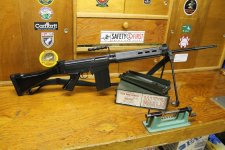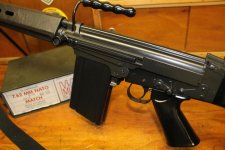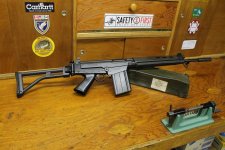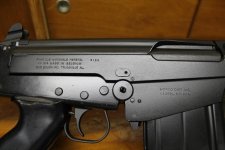That's a kind assessment. Here's mine.
Colonel Studler of the Ordnance Department went into full "not invented here" mode towards any of the European suggestions. As a result NATO got saddled with a full power cartridge when they needed an intermediate one. Later on a lot of taxpayers' money was wasted in the Western world building different weapons when the mistake was realized and 5.56 came along.
Next up, 6.8 SPC, or "How the Brits and the Belgians got it right in the first place in 1950".
Pretty much this. ^
Studler was a fan of the .30 Light Rifle round before he went to Springfield Armory and the .30 Light Rifle cartridge became the T65 cartridge (a .30-06 shortened to .300 Savage length, but using new propellant to get nearly the same ballistics as the .30-06 M2 ball round).
The attraction of the .30 Light Rifle / T65 to the Ordnance Department was a full battle rifle round that fed more reliably in a full auto service rifle. That of course ignored the fact that a full power round was virtually uncontrollable in a service rifle, but the bias toward a full power round was incredibly strong at higher levels, since the .30-06 had served so well in WWI and WWII.
This bias that the .30-06 "performed well" was true enough in the semi-auto Garand. However it ignored the tactical advantages demonstrated by the German 7.92x33 Kurz round and the near copy Soviet M43 7.62x39 round in suitable assault rifle designs that were well suited to the reality, well documented during WWII, that virtually all infantry engagements occured at ranges of 300 yards or less.
Make no mistake, it was always all about getting a full power round. One of the excuses given by the US Ordnance Dept advocating for the T65 cartridge was that they wanted to be able to utilize most of the existing tooling to produce the new round, and the T65 met that requirement by having .30-06 case head dimensions.
So the British accommodated that request and quickly developed .280/30, which was basically the .280 British modified to have the same case head dimension as the .30-06 and T-65 cartridges.
The British designed the EM-2 around the .280 British, and it performed very well in US trials but the Ordnance Dept objected to the small caliber for use in a common caliber machine gun. The argument against the .280 Brit was essentially the smaller beaten beaten zone of the lower velocity round. The Beaten zone is an indirect fire concept defined as the distance between first catch (the distance at which a found will hit a standing soldier in the head) and "last graze" (the distance at which the round will hit a standing soldier in the foot).
Once the compromise .280/30 was rejected, the US forced the T65 cartridge, now adopted as the 7.62x51mm NATO, down NATO's throat.
The metric pattern FAL was slightly redesigned to accommodate the 7.62 NATO round. The FN FAL design was then also tweaked to use inch dimensions as the L1A1 for the British, since the EM-2 (already in limited British service chambered in .280 British) was not able to be redesigned for the larger 7.62x51 NATO.
Both the FN FAL and L1A1 shared the same problem as the M14 - near uncontrollability in full auto fire, with the result that the commonwealth L1A1s were semi-auto only, with only the heavy barreled L1A2 and Canadian C2A1, and the Canadian C1s being select fire.
The 7.62x51 NATO was adopted in 1954 with the M14, FN FAL, L1A1 and West German G1 (West German version the FAL) not entering service until 1957, with the G1 then being supplanted/replaced by the G3 beginning in 1959.
The final insult of course is that the US military began development of the .224 Springfield (a lengthened development of the .22 Remington) in 1957 - just 3 years after forcing NATO to adopt the 7.62 NATO and before rifles using it were fully in service.
The M193 round was accepted for service 6 years later in 1963, but NATO didn't sign off on an agreement to develop a new smaller caliber NATO round until 1970, and the SS109 / M555 5.46x45mm NATO round wasn't adopted until 1980.
Worse, that round and its SS109, 62 grain projectile, arguably watered down the wounding potential of the original M193 round, in preference to a long range penetration requirement that was a hold over from the 7.62x51 NATO.
Thus once again achieving a total screw up in small arms ammunition procurement of a NATO round.
-----
The .280 Brit launched a 140 grain .284" bullet at 2,550 fps. That compares quite well to the current 6.8 SPC (120 grain bullet at 2,460 fps) and the 6.5 PPC / 6.5 Grendel (130 gr bullet at 2,510 fps), all of which have been promoted over the last decade or so as much more "modern" and much better choices for a service cartridge.
It's ironic that we're now planning to adopt the 6.8 SPC a full 74 years after the .280 British was developed - and once again were doing it without NATO buy in.
If they have any sense of history they have to be thinking:
"Really? You wasted 74 years and NOW you're ok with a .280 Brit like round?"






